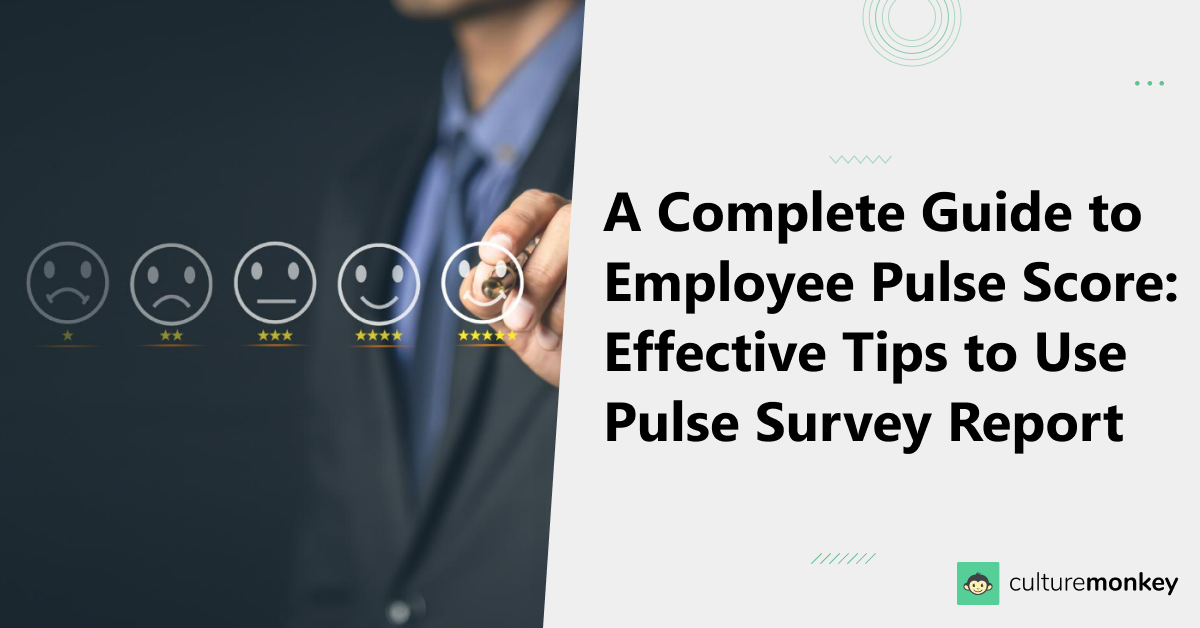A Complete Guide to Employee Pulse Score: Effective Tips to Use Pulse Survey Report

Is it possible to develop workplace engagement without spending too much time with employees? Are employees ready to spend an extended amount of time providing proper feedback?
Employee development is a critical part of employee retention and the overall performance improvement of a company. Investing in employee development includes increased productivity, higher morale, improved customer service, and lower turnover costs.
Employees who get engaged at work perform better, stay longer and become more productive. In addition, they also experience less stress and anxiety and enjoy greater job satisfaction. It makes sense to invest in employee development programs.
But a survey that takes more than a few minutes isn't the most popular way among employees to provide comprehensive feedback. So this is where the pulse score kicks in to help measure overall employee engagement and satisfaction.
The pulse score is typically based on a survey sent out to employees, asking them to rate their current satisfaction and engagement levels with their role and the workplace. The survey scores can be used to identify areas of improvement and to gauge employee morale.
So survey scores acts as a primary method to understand an organization's overall health and engagement to measure progress over time. Now let's dive deep into why pulse score is more crucial than you think.
Table of contents:-
- What is an employee pulse survey?
- Benefits of employee pulse surveys
- Pulse surveys vs. annual engagement surveys
- Crucial tips for running more engaged pulse surveys
- How is a pulse survey score calculated?
- How to effectively use the pulse survey score?
- Top 10 pulse survey questions to ask your employees
What is an employee pulse survey?

An employee pulse survey measures employees' overall satisfaction and engagement in a workplace. The survey scores are usually administered regularly, such as every quarter or every six months, and is designed to measure employee morale, workplace satisfaction, and other factors contributing to employee engagement.
Employee pulse surveys are typically short, consisting of a few questions. These questions often focus on specific topics such as workplace morale, job satisfaction, work/life balance, and overall engagement. This allows employers to quickly get an idea of how their employees are feeling and what areas may need improvement.
Employee pulse report can be beneficial for employers because they provide feedback on a regular basis. This feedback allows employers to identify areas of improvement and take necessary steps to address any issues that arise.
Additionally, these survey data provide a platform for employees to voice their concerns and suggestions, which helps employers create a more positive work environment.
Benefits of employee pulse surveys

Employee pulse report offer a great way for employers to gain valuable insights into the work environment and employee engagement. They help identify areas of improvement, foster better communication between management and employees, and provide a platform for employers to take proactive measures to tackle issues that could affect productivity.
The following are the benefits of employee pulse surveys:
Enhanced productivity and profits
Business leaders are beginning to take notice of the significant costs associated with low employee engagement. With a lack of enthusiasm and effort from disengaged employees, businesses are far from reaching their potential.
On the other hand, highly engaged employees go above and beyond to ensure that productivity and profitability are maximized. As a result, businesses can benefit immensely from fostering a positive workplace culture that encourages and rewards employee engagement.
Reduces absenteeism and long-term sickness
Absenteeism and extended periods of sick leave can have a detrimental effect on a business, and it can cause projects to take longer and productivity to decrease. While some absence due to illness and injury is unavoidable, other factors can be addressed to reduce the number of absences.
Stress and lack of engagement in the workplace are common causes, and creating a positive work environment can help reduce sick leave.
In addition, it is important to create a sense of engagement for employees and to ensure that they are happy in their roles. This can lead to a decrease in the number of absences due to illness, ultimately providing a boost to productivity and morale.
Builds stronger brand
Engaging employees is essential for creating a desirable employer brand. Without employees feeling committed and fulfilled in their roles, effectively promoting the company as an attractive workplace won't be easy. Social media has increased the need for transparency, so the best way to strengthen the employer brand is to focus on employee experience and engagement.
Reduces attrition rate
There is a clear connection between employee engagement and a reduction in staff turnover. When an individual is engaged in and passionate about work they do, they are more likely to stay with the company. This has a positive impact on the company's productivity and profitability.
Companies that invest in creating an environment where employees feel an emotional connection to their work and are motivated to achieve their best will benefit from higher engagement and a lower turnover rate.
Pulse surveys vs. annual engagement surveys

Pulse and annual engagement surveys are two of the most common employee engagement tools used by organizations today. While both are designed to measure employee satisfaction and engagement, they differ in several key ways.
Pulse surveys are short, frequent surveys that provide managers with an ongoing assessment of employee sentiment. They are typically conducted on a weekly or monthly basis and are used to evaluate current employee satisfaction with their job, the organization, and other areas of the workplace.
Pulse surveys provide up-to-date feedback that can help employers identify areas of improvement or dissatisfaction quickly and make changes to address any issues.
On the other hand, annual engagement surveys are comprehensive surveys that are administered once a year for yearly data. They are a more comprehensive approach to measuring employee engagement and typically cover a variety of topics, such as job satisfaction, organizational culture, and management practices.
Annual engagement survey data provide an in-depth look into employee sentiment, and are often used to benchmark performance and track changes over time.
When used together, surveys and annual engagement surveys can provide organizations with a comprehensive view of how employees are feeling.
Both surveys are valuable tools for measuring employee engagement. Pulse surveys provide a more immediate assessment of employee sentiment, while annual engagement surveys provide a more in-depth look into employee satisfaction.
Crucial tips for running more engaged pulse surveys

Pulse survey is a great way to gauge how employees feel on an ongoing basis rather than waiting for a yearly engagement survey's percentage. Here are some tips to ensure your surveys are more engaging and effective.
- Make it short and sweet: Keep your surveys short, with no more than 8-10 questions, which will help ensure your employees are more likely to complete them.
- Make it relevant: Ensure the questions you ask are relevant to your organization and the specific needs of your employees. This will help ensure the survey is more engaging and the results are more meaningful.
- Make it simple: Use a simple 0–10 scale method to answer multiple-choice questions to make it easier for employees to answer quickly and accurately.
- Keep it anonymous: Anonymity is key to getting honest responses from employees. Make sure employees feel comfortable giving their honest opinions without fear of retribution.
- Offer incentives: Offering incentives is a great way to encourage employees to complete the survey. This could be anything from a vacation time to a gift card.
- Make it interactive: Using interactive features such as videos or polls can make surveys more engaging and interesting.
- Personalize it: Personalize the survey by incorporating questions about specific topics or issues that are relevant to your organization.
- Follow up: Make sure to follow up with employees after they complete the survey. This will demonstrate that you value their feedback and are working to make improvements based on their responses.
By following these tips, you can ensure your surveys are more engaging and effective. By collecting timely and meaningful feedback from employees, you can better understand their needs and make improvements to create a more engaging and productive workplace.
How is a pulse survey score calculated?

Employee pulse survey scores is a measurement used to assess the overall health of a workplace. The overall score is calculated by gathering employees' responses about their workplace experiences and using a set of questions and metrics to assess their overall satisfaction.
The first step in calculating an employee pulse score is determining which questions to ask. The questions should be tailored to the specific working environment and focus on job satisfaction, engagement, and morale.
Once the questions have been determined, the responses can be collected via an online pulse score survey. The responses are then analyzed to determine the overall score. Typically, a numerical score is assigned to each response, and an overall average is calculated. The average score can then be compared to other organizations to gain insight into workplace culture.
When interpreting the employee pulse score, it is crucial to consider the context and other factors that may influence the results. For example, a low score may be a sign that employees are dissatisfied with their job, but it could also be a sign of a larger cultural issue within the organization. It is also important to look beyond the score and consider any potential underlying issues contributing to the results.
By gathering feedback from employees and analyzing the results, organizations can gain insight into their employees' overall job satisfaction and morale. This information can then be used to make changes to improve the workplace and create a more positive work environment.
How to effectively use the pulse survey score?

Employee pulse score survey are an invaluable tool for organizational leaders to gain insights into the overall morale, team engagement, and satisfaction of their workforce.
By taking the time to evaluate the survey percentage, organizations can gain valuable insights into the effectiveness of their policies and practices. This can help them make informed decisions that will improve employee morale and team engagement.
- The first step in making the most of the employee's pulses score is thoroughly reviewing the survey results. Organizations should look for patterns and trends in the data, such as the types of questions that received the highest or lowest scores, or the overall satisfaction rating. This can help them identify areas where improvement is needed.
- Organizations should also consider feedback from individual employees. While the overall survey results provide valuable insights, it is also important to understand the experiences and opinions of individual employees. This can be done by conducting follow-up interviews or surveys to understand better the employee's view of the organization and its practices.
- Once the survey results have been evaluated and the feedback from individual employees has been gathered, organizations should develop an action plan to address any areas of concern identified in the survey. This plan should include specific objectives, goals, strategies, and tactics to reach those objectives.
- Organizations should also develop a system to track progress on the action plan. This should include regular check-ins with employees to ensure that the desired changes are being implemented. It should also include regular surveys to evaluate the effectiveness of the action plan and to identify any additional areas that need to be addressed.
- Finally, organizations should communicate the survey results and action plan to all employees. This will help ensure that employees understand the importance of the survey and the action plan and that they are willing to participate in the process.
By taking the time to evaluate the survey results, develop an action plan, and communicate the results to all employees, organizations can make the most of the employee pulse score. Doing so will improve employee morale and team engagement and lead to a more productive and successful workforce.
Understanding how employee pulse score is helpful for leaders to calculate and measure employee engagement and necessarily follow a positive work culture, as well as how employees’ surveys can help achieve organizational engagement objectives.
Irrespective of the size of your company, CultureMonkey will help you gather your employees' pulse score. It is possible for organizations of any size to quickly and easily launch pulse score survey and gain immediate insights, as well as automated action plans.
Top 10 pulse survey questions to ask your employees [Scale of 0–10]
- Do you feel burnout or stressed due to work or the workplace?
- Do you find your work meaningful and fulfilling?
- Are you with our company's job securities and policies?
- Is your work-life balance in your current position at our organization?
- Do you feel your manager acts as your support system?
- How strongly do you agree that our organization provides opportunities to develop and grow?
- Do you believe that our organization is fair and transparent with its decisions?
- Are you with your benefits and compensation package?
- Do you think that our organization's culture is diverse enough?
- Are you connected with our organization's mission and values?



